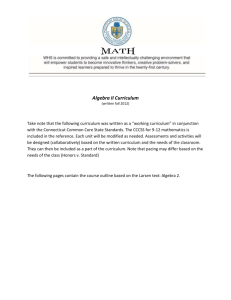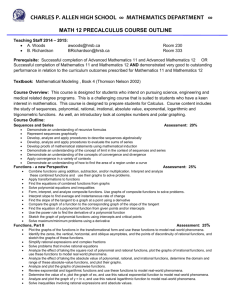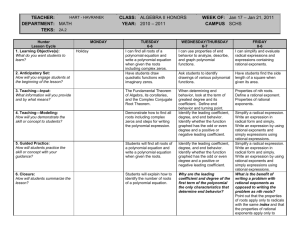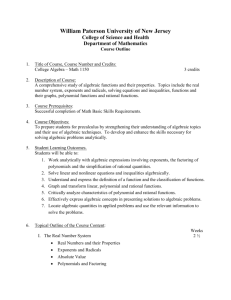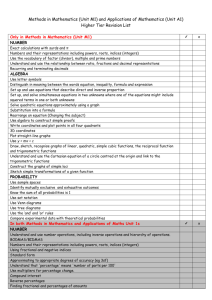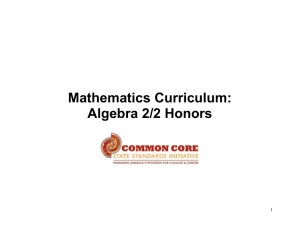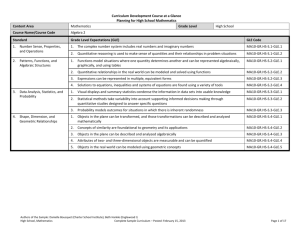Mathematics | High School—Algebra III Course Algebra III, a one
advertisement
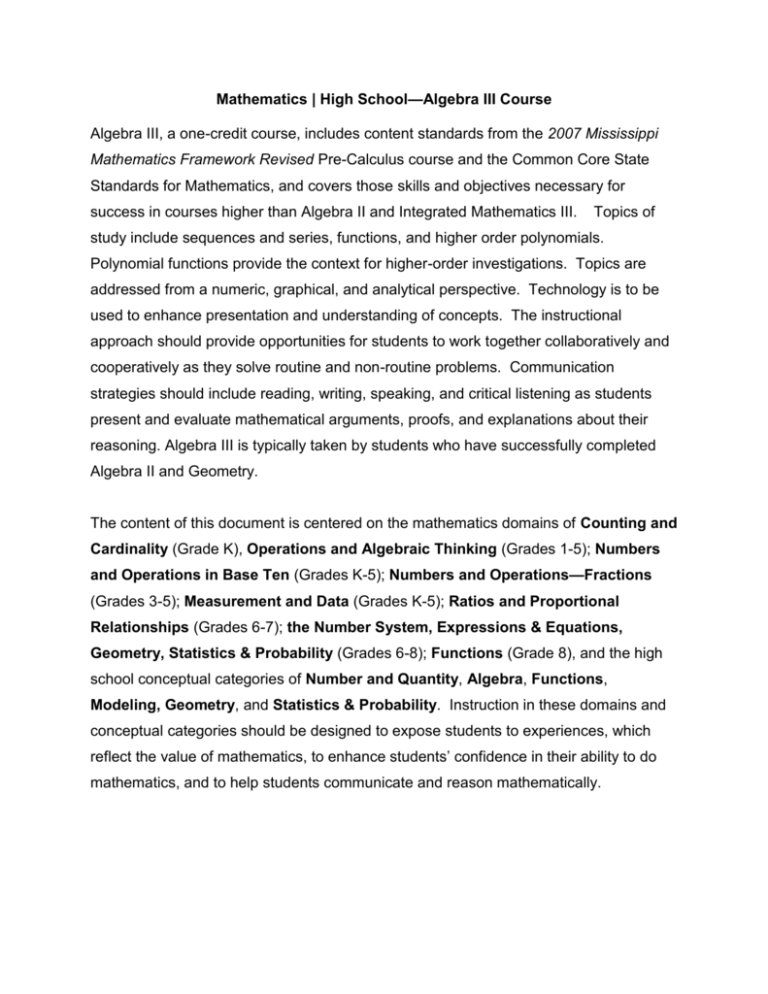
Mathematics | High School—Algebra III Course Algebra III, a one-credit course, includes content standards from the 2007 Mississippi Mathematics Framework Revised Pre-Calculus course and the Common Core State Standards for Mathematics, and covers those skills and objectives necessary for success in courses higher than Algebra II and Integrated Mathematics III. Topics of study include sequences and series, functions, and higher order polynomials. Polynomial functions provide the context for higher-order investigations. Topics are addressed from a numeric, graphical, and analytical perspective. Technology is to be used to enhance presentation and understanding of concepts. The instructional approach should provide opportunities for students to work together collaboratively and cooperatively as they solve routine and non-routine problems. Communication strategies should include reading, writing, speaking, and critical listening as students present and evaluate mathematical arguments, proofs, and explanations about their reasoning. Algebra III is typically taken by students who have successfully completed Algebra II and Geometry. The content of this document is centered on the mathematics domains of Counting and Cardinality (Grade K), Operations and Algebraic Thinking (Grades 1-5); Numbers and Operations in Base Ten (Grades K-5); Numbers and Operations—Fractions (Grades 3-5); Measurement and Data (Grades K-5); Ratios and Proportional Relationships (Grades 6-7); the Number System, Expressions & Equations, Geometry, Statistics & Probability (Grades 6-8); Functions (Grade 8), and the high school conceptual categories of Number and Quantity, Algebra, Functions, Modeling, Geometry, and Statistics & Probability. Instruction in these domains and conceptual categories should be designed to expose students to experiences, which reflect the value of mathematics, to enhance students’ confidence in their ability to do mathematics, and to help students communicate and reason mathematically. Number and Quantity Explore and illustrate the characteristics and operations connecting sequences and series Express sequences and series using recursive and explicit formulas. Evaluate and apply formulas for arithmetic and geometric sequences and series. Calculate limits based on convergent and divergent series. Evaluate and apply infinite geometric series. Extend the meaning of exponents to include rational numbers. Simplify expressions with fractional exponents to include converting from radicals. Factor algebraic expressions containing fractional exponents. Algebra Analyze and manipulate functions Determine characteristics of graphs of parent functions (domain/range, increasing/decreasing intervals, intercepts, symmetry, end behavior, and asymptotic behavior). Determine the end behavior of polynomial functions. Use polynomial identities to solve problems Prove polynomial identities and use them to describe numerical relationships. For example, the polynomial identity (x can be used to generate Pythagorean triples. Verify the Binomial Theorem by mathematical induction or by a combinatorial argument. Know and apply the Binomial Theorem for the expansion of (x + y)n in powers of x and y for a positive integer n, where x and y are any numbers, with coefficients determined for example by Pascal’s Triangle. 𝑥 3 − 𝑥2 −𝑥+1 Write rational expressions in simplest form. (For example, 𝑥 3 +𝑥 2 −𝑥−1 = Decompose a rational function into partial fractions. 𝑥−1 ). 𝑥+1 Determine asymptotes and holes of rational functions, explain how each was found, and relate these behaviors to continuity. Perform operations on expressions, equations, inequalities and polynomials Add, subtract, multiply and divide rational expressions. Solve polynomial and rational inequalities. Relate results to the behavior of the graphs. Find the composite of two given functions and find the inverse of a given function. Extend this concept to discuss the identity function f(x) = x. Simplify complex algebraic fractions (with/without variable expressions and integer 𝑓(𝑥+ℎ)−𝑓(𝑥) exponents) to include expressing as a single simplified fraction when f(x) = ℎ 1 1−𝑥 for example. Find the possible rational roots using the Rational Root Theorem. Find the zeros of polynomial functions by synthetic division and the Factor Theorem. Graph and solve quadratic inequalities. Functions Analyze functions using different representations Graph functions expressed symbolically and show key features of the graph, by hand in simple cases and using technology for more complicated cases. Graph rational functions, identifying zeros and asymptotes when suitable factorizations are available, and showing end behavior. Build a function that models a relationship between two quantities Verify by composition that one function is the inverse of another. Read values of an inverse function from a graph or a table, given that the function has an inverse. Produce an invertible function from a non-invertible function by restricting the domain. Understand the inverse relationship between exponents and logarithms and use this relationship to solve problems involving logarithms and exponents. Extend the domain of trigonometric functions using the unit circle Use special triangles to determine geometrically the values of sine, cosine, tangent for p/3, p/4 and p/6, and use the unit circle to express the values of sine, cosine, and tangent for p–x, p+x, and 2p–x in terms of their values for x, where x is any real number. Use the unit circle to explain symmetry (odd and even) and periodicity of trigonometric functions. Model periodic phenomena with trigonometric functions Understand that restricting a trigonometric function to a domain on which it is always increasing or always decreasing allows its inverse to be constructed. Use inverse functions to solve trigonometric equations that arise in modeling contexts; evaluate the solutions using technology, and interpret them in terms of the context. Prove and apply trigonometric identities Prove the addition and subtraction formulas for sine, cosine, and tangent and use them to solve problems. Geometry Recognize, sketch, and transform graphs of functions Graph piecewise defined functions and determine continuity or discontinuities. Describe the attributes of graphs and the general equations of parent functions (linear, quadratic, cubic, absolute value, rational, exponential, logarithmic, square root, cube root, and greatest integer). Explain the effects of changing the parameters in transformations of functions. Predict the shapes of graphs of exponential, logarithmic, rational, and piece-wise functions, and verify the prediction with and without technology. Relate symmetry of the behavior of even and odd functions. Apply trigonometry to general triangles Derive the formula A = 1/2 ab sin(C) for the area of a triangle by drawing an auxiliary line from a vertex perpendicular to the opposite side. Prove the Laws of Sines and Cosines and use them to solve problems. Understand and apply the Law of Sines and the Law of Cosines to find unknown measurements in right and non-right triangles (e.g., surveying problems, resultant forces). Statistics and Probability Explore and apply fundamental principles of probability. Analyze expressions in summation and factorial notation to solve problems. Prove statements using mathematical induction.

